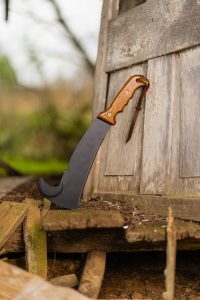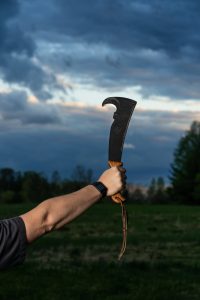Skinning an animal is a skill to be possessed by all responsible outdoorsmen and hunters. Whether you are field dressing the animal for the hike out or cooking them on the spot, skinning your kill can be incredibly difficult without the right tools. A minimum requirement to get the job done is a sharp blade of any kind, but specific blade designs are far more effective.
To answer the question, is a machete good for skinning? The answer would be both yes and no and entirely depends on the type of machete you have.
This blog post covers everything you need to know about the different types of machetes.
Machetes for Skinning
Skinning an animal requires controlled and semi-precise cuts, which can be challenging to achieve when dealing with a longer machete. This is why if you are going to use a machete to skin your kill, ideally, you would want to go with a shorter one. This will make the process of field dressing much more manageable and drastically reduces the chance of injuring yourself in the process.
Blade Design
Skinning with a machete can be difficult, but the ideal blade design paired with a practiced hand makes quick work of the process. Skinning an animal with a machete can be a long, arduous process, so to prevent unnecessary fatigue, a light machete is ideal.
animal with a machete can be a long, arduous process, so to prevent unnecessary fatigue, a light machete is ideal.
In addition to opting for a lightweight tool, you want to make sure the weight is evenly distributed and balanced across the entire length of the machete. Overall, light and a balanced distribution reduce the chance of fatigue and injury through quick and precise cuts.
Skinning an animal is a game of precision, a level of which can only be achieved with a blade of an ideal design. A trait to look for is the thickness of the blade. Ideally, you want a blade that is as thin as possible while at the same time thick enough to resist breaking should you need to use it for other tasks.
This is also going to allow your blade to flex, increasing the overall maneuverability when working. Going with a thin blade also serves as a great way to cut down on the overall weight.
Another key trait of an efficient skinning blade is a balanced curving that ends at the tip of the blade. The gradual curve of the blade allows you to make long and precise cuts to streamline the skinning process. Bowie machetes are ideal for those that plan on using their machete to skin their kill.
The tip is fashioned after the Bowie Knife, specially made to carve through skin and meat with ease. Although this is only commonly found on knives and not machetes, there could be an additional severe curve on the spine of the blade to serve as a gut hook to further the efficiency of the process.
All of these traits seem minuscule when compared to the only one that is truly necessary for a machete to work as a skinning knife – quality steel. Not only does quality steel make for a blade that will last you a long time, but it is the only material that can sustain the highly sharp edge required of a skinning tool.
Other lower quality materials will quickly lose their advantage and make the process take much longer than it should. Not only that, but a sharp blade is substantially safer too
Machete Vs. Skinning Knife
When it comes to skinning an animal, a fixed blade skinning knife is the best option out there. Other blades will suffice and even do a good job, but nothing will work better than a quality tool explicitly crafted for skinning. If you plan on carrying a machete but don’t feel like packing along an additional blade, then we highly suggest you go with a short model Bowie machete.
but nothing will work better than a quality tool explicitly crafted for skinning. If you plan on carrying a machete but don’t feel like packing along an additional blade, then we highly suggest you go with a short model Bowie machete.
This machete type will make skinning efficient and accurate while also serving as a versatile outdoor and survival tool. Still not sure if you want a machete or a knife? Check out this blog post comparing the practicality of the two devices in different scenarios.
Woodman’s Pal
Suppose you are looking for a compact tool unmatched in versatility, head on over to our store and check out our original Woodman’s Pal. This outdoor survival tool started being produced in 1941 and has a design that incorporates the best traits of machetes and knives from around the world.


